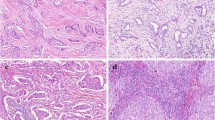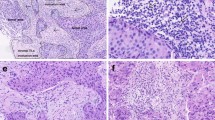Abstract
Objectives
Tumor-infiltrating lymphocytes (TILs) have been determined as a new prognostic indicator of immunotherapy response in breast cancer (BC). The aim of this study is to investigate the effectiveness of imaging features in predicting the TIL levels in invasive BC patients.
Methods
A total of 158 patients with invasive BC were included in our study. All lesions were evaluated based on the BIRADS lexicon. US was performed for all the patients and 89 of them underwent MRI. The histologic stromal TIL (sTIL) levels were assessed and associations between the sTIL levels and imaging features were evaluated.
Results
Tumors with high sTIL levels had more circumscribed margins, round shape, heterogeneous echogenicity, and larger size on ultrasonography (p < 0.005). There was a statistically significant positive correlation between the sTIL levels and ADC value (p < 0.001). Tumors with high sTIL levels had significantly more homogeneous enhancement than the tumors with low sTIL levels (p = 0.001). Logistic regression analysis showed that the ADC was the most statistically significant parameter in predicting the sTIL levels (the odds ratio was 90.952; p = 0.002). The optimal cutoff value for ADC in predicting low and high sTIL levels was found to be 0.87 × 10−3 mm2 s−1 (AUC = 0.726, 73% specificity, and 60% sensitivity).
Conclusions
Imaging findings, especially the ADC, may play an important role as an adjunct tool in cases of uncertain situations and may improve the accuracy of biopsy results. The prediction of sTIL levels using imaging findings may give an opportunity to predict prognosis.
Key Points
• Preoperative assessment of TILs is an important biomarker of prognosis and treatment efficacy.
• ADC value can be a useful tool in distinguishing high and low sTIL levels as a non-invasive method.
• The prediction of sTIL levels using imaging findings may give an opportunity to predict prognosis and an optimal treatment for the BC patients.




Similar content being viewed by others
Abbreviations
- ADC:
-
Apparent diffusion coefficient
- AUC:
-
Area under the curve
- BC:
-
Breast cancer
- BI-RADS:
-
Breast Imaging Reporting and Data System
- DWI:
-
Diffusion-weighted imaging
- ER:
-
Estrogen receptor
- HER2:
-
Human epidermal growth factor receptor 2
- IHC:
-
Immunohistochemical
- Lum:
-
Luminal
- MRI:
-
Magnetic resonance imaging
- NAC:
-
Neoadjuvant chemotherapy
- pCR:
-
Pathological complete response
- ROC:
-
Receiver operating characteristic analysis
- TIL:
-
Tumor-infiltrating lymphocyte
- TN:
-
Triple negative
- US:
-
Ultrasonography
References
Bray F, Ferlay J, Soerjomataram I, Siegel RL, Torre LA, Jemal A (2018) Global cancer statistics GLOBOCAN estimates of incidence and mortality worldwide for 36 cancers in 185 countries. CA Cancer J Clin 6:394–424
Luen SJ, Savas P, Fox SB, Salgado R, Loi S (2017) Tumour-infiltrating lymphocytes and the emerging role of immunotherapy in breast cancer. Pathology 2:141–155
Denkert C (2013) Diagnostic and therapeutic implications of tumor-infiltrating lymphocytes in breast cancer. J Clin Oncol 7:836–837
Dieci MV, Radosevic-Robin N, Fineberg S et al (2018) Update on tumor-infiltrating lymphocytes (TILs) in breast cancer, including recommendations to assess TILs in residual disease after neoadjuvant therapy and in carcinoma in situ: a report of the International Immuno-Oncology Biomarker Working Group on Bre. Semin Cancer Biol. https://doi.org/10.1016/j.semcancer.2017.10.003
Salgado R, Denkert C, Campbell C et al (2015) Tumor-infiltrating lymphocytes and associations with pathological complete response and event-free survival in HER2-positive early-stage breast cancer treated with lapatinib and trastuzumab: a secondary analysis of the NeoALTTO trial. JAMA Oncol 4:448–455
Spak DA, Plaxco JS, Santiago L, Dryden MJ, Dogan BE (2017) BI-RADS® fifth edition: a summary of changes. Diagn Interv Imaging. https://doi.org/10.1016/j.diii.2017.01.001
Goldhirsh A, Winer EP, Coates AS et al (2013) Personalizing the treatment of women with early breast cancer: highlights of the St Gallen International Expert consensus on the primary therapy of early breast cancer. Ann Oncol 24:2206–2223
Pruneri G, Vingiani A, Denkert C (2018) Tumor infiltrating lymphocytes in early breast cancer. Breast 37:207–214
Asano Y, Kashiwagi S, Goto W et al (2018) Prediction of treatment response to neoadjuvant chemotherapy in breast cancer by subtype using tumor-infiltrating lymphocytes. Anticancer Res. https://doi.org/10.1158/1538-7445.sabcs15-p3p07-33
Mao Y, Qu Q, Zhang Y, Liu J, Chen X, Shen K (2014) The value of tumor infiltrating lymphocytes (TILs) for predicting response to neoadjuvant chemotherapy in breast cancer: a systematic review and meta-analysis. PLoS One. https://doi.org/10.1371/.pone.0115103
Denkert C, von Minckwitz G, Darb-Esfahani S et al (2018) Tumour-infiltrating lymphocytes and prognosis in different subtypes of breast cancer: a pooled analysis of 3771 patients treated with neoadjuvant therapy. Lancet Oncol 1:40–50
Ku YJ, Kim HH, Cha JH et al (2016) Correlation between MRI and the level of tumor-infiltrating lymphocytes in patients with triple-negative breast cancer. AJR Am J Roentgenol 5:1146–1151
Fogante M, Tagliati C, De Lisa M, Berardi R, Giuseppetti GM, Giovagnoni A (2019) Correlation between apparent diffusion coefficient of magnetic resonance imaging and tumor-infiltrating lymphocytes in breast cancer. Radiol Med. https://doi.org/10.1007/s11547-019-01008-w
Fukui K, Masumoto N, Shiroma N et al (2019) Novel tumor-infiltrating lymphocytes ultrasonography score based on ultrasonic tissue findings predicts tumor-infiltrating lymphocytes in breast cancer. Breast Cancer. https://doi.org/10.1007/s12282-019-00958-3
Ku YJ, Kim HH, Cha JH et al (2018) Predicting the level of tumor-infiltrating lymphocytes in patients with triple-negative breast cancer: usefulness of breast MRI computer-aided detection and diagnosis. J Magn Reson Imaging 3:760–766
Wu J, Li X, Teng X et al (2018) Magnetic resonance imaging and molecular features associated with tumor-infiltrating lymphocytes in breast cancer. Breast Cancer Res. https://doi.org/10.1186/s13058-018-1039-2
Denkert C, Von Minckwitz G, Brase JC et al (2015) Tumor-infiltrating lymphocytes and response to neoadjuvant chemotherapy with or without carboplatin in human epidermal growth factor receptor 2-positive and triple-negative primary breast cancers. J Clin Oncol 9:983–991
Shin HJ, Kim SH, Lee HJ et al (2016) Tumor apparent diffusion coefficient as an imaging biomarker to predict tumor aggressiveness in patients with estrogen-receptor-positive breast cancer. NMR Biomed 8:1070–1078
Choi WJ, Kim Y, Cha JH et al (2019) Correlation between magnetic resonance imaging and the level of tumor-infiltrating lymphocytes in patients with estrogen receptor-negative HER2-positive breast cancer. Acta Radiol. https://doi.org/10.1177/0284185119851235
Ali HR, Provenzano E, Dawson SJ et al (2014) Association between CD8+ T-cell infiltration and breast cancer survival in 12 439 patients. Ann Oncol 8:1536–1543
Schalper KA, Velcheti V, Carvajal D et al (2014) In situ tumor PD-L1 mRNA expression is associated with increased TILs and better outcome in breast carcinomas. Clin Cancer Res 10:2773–2782
Liu S, Foulkes WD, Leung S et al (2014) Prognostic significance of FOXP3+ tumor-infiltrating lymphocytes in breast cancer depends on estrogen receptor and human epidermal growth factor receptor-2 expression status and concurrent cytotoxic T-cell infiltration. Breast Cancer Res. https://doi.org/10.1186/s13058-014-0432-8
Acknowledgments
The authors would like to thank Enago (www.enago.com) for the English language review.
Funding
The authors state that this work has not received any funding.
Author information
Authors and Affiliations
Corresponding author
Ethics declarations
Guarantor
The scientific guarantor of this publication is the corresponding author.
Conflict of interest
The authors of this manuscript declare no relationships with any companies whose products or services may be related to the subject matter of the article.
Statistics and biometry
No complex statistical methods were necessary for this paper.
Informed consent
Written informed consent was not required for this study because the study was retrospective.
Ethical approval
Institutional Review Board approval was obtained.
Study subjects or cohorts overlap
There is no overlap on the study subjects.
Methodology
• retrospective
• diagnostic or prognostic study
• performed at one institution
Additional information
Publisher’s note
Springer Nature remains neutral with regard to jurisdictional claims in published maps and institutional affiliations.
Rights and permissions
About this article
Cite this article
Çelebi, F., Agacayak, F., Ozturk, A. et al. Usefulness of imaging findings in predicting tumor-infiltrating lymphocytes in patients with breast cancer. Eur Radiol 30, 2049–2057 (2020). https://doi.org/10.1007/s00330-019-06516-x
Received:
Revised:
Accepted:
Published:
Issue Date:
DOI: https://doi.org/10.1007/s00330-019-06516-x




